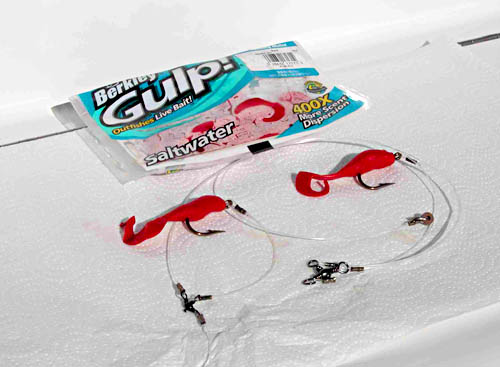
How to Catch Ensenada Rock Cod
![]()
|
BERKLEY GULP BAITS--This is my Gulp setup. I employ three-way swivels in the line, 2 feet apart, and stick the Gulps onto bare hooks. That's all you need all day. Photo courtesy Steve Ross. |
GOING DEEP WITH GANIONS OF BERKLEY GULP BAITS
March 16, 2006, by Steve "Bad Dog" Ross:
Rockcodding is alive and well across the Mexican border. Whether you're a private boater, a Marina Coral charter boater, or in the Vonny's Fleet panga, Ensenada is the hot rockcod location.
To fish for Ensenada's rockcod, you need to find rocks that are usually located on a bank. On Bad Dog's last trip a few weeks ago, we found rocks in 100, 200 and 300 feet of water off Bajamar and Salsepuedes, the former known as "shallow water rockcod." The Baja coastline is loaded with fishy spires and the Banda Bank has plentiful rocks from the top to the bottom.
|
|
You will need an excellent depth (fish) finder. I bought the Furuno Color LCD Video Sounder FCV-1100L, which has a split screen for high and low frequencies, and the transducer is the size of your arm. You need to collect numbers for rocks on banks. To find rockcod, look for a "blue fuzz ball" on top of a "red rock" on your meter.
We make sure our fishing rods are at the ready and baited, and when I yell "okay" the baits are let go immediately. It is very important that the baits fly down to the spot as soon as possible and not miss their mark. Keep returning and dropping on that waypoint.
After three or four times, the fish will stop biting. Find another rock and if it's holding fish, drop on it. If you don't see fish on your meter, there aren't any.
Rocks don't move, so keep all the numbers stored in your finder.
The best fish-producing gangion is a series of dropper loops on the main line. Two dropper loops, 2 feet apart, will allow you to attach two, 4/0 live bait hooks by inserting the loop and cinching the hook.
You will catch more rockcod by using strips of squid as opposed to whole squid. Many times I have reeled up whole-bodied squid with no heads and no fish attached. Sometimes, it is said that anchovies work best and sardines the least.
|
|
When rockcod fishing, the big question is, "When do I reel up 400 feet of line?" If you use a Penn 4/0 reel with 40-pound mono main line on a stiff rod and an 8-ounce sinker, you will be fishing like an amigo. With each bite, strike the fish back hard, driving the 4/0 hook into a lip lock. You will feel the rattling down below. For the ultimate sensitivity, opt for pricey spectra line on a graphite rod.
There might be one situation that ruins your day while working the depths. You drop to 400 feet and it immediately gets stuck on the bottom. I have asked several experts what they think is stuck, the sinker or a hook. I concluded recently that it's the sinker. You can pull on your rod until it snaps and the sinker won't come out of its hole.
But if you install a cleat, you can put the reel in free spool and wrap the mainline around the cleat and let the weight of your boat pull your tackle out. Installing a Duolock 20-pound snap to attach the sinker will allow the gangion to return with all the fish, but without the sinker.
Upon returning, chill, gill, gut and scale a red vermilion and take it to Loreto at Las Cazuelas and have it cooked whole, head-on, "pesca frito," and you will become a devoted Ensenada rockcodder.
While plastic swimbaits are great for rockcod fishing, I was introduced to Berkley's Gulp baits a few weeks ago. These organic baits are a different and revolutionary product. They use scientifically developed scent to deceive fish.
Berkley Gulp baits are made of 100 percent natural ingredients, not plastic, and they release a scent trail. The size causes the fish to suck up the whole bait for a solid hookset.
We found Berkley Gulp bait extremely hardy and used them over and over. On shrimp-fly gangions, simply slide a gulp onto the hook and up the shank. The best advantage is that you don't lose your bait from a strike; it keeps fishing until a fish is hooked.
• Steve Ross has been fishing off Southern California and Baja California, Mexico, for more than 50 years. He runs his sportfisher, Bad Dog, out of Marina Coral in Ensenada, Baja California.
(Related Ensenada articles and reports may be found at Mexfish.com's main Ensenada information page. See weekly fishing news, photos, and reports from the major sportfishing vacation areas of Mexico including the Ensenada area in "Mexico Fishing News.")
MEXICO FISHING INFO ENSENADA FISHING INFO "WEEKLY MEXICO FISHING NEWS" FISH PHOTO GALLERY
